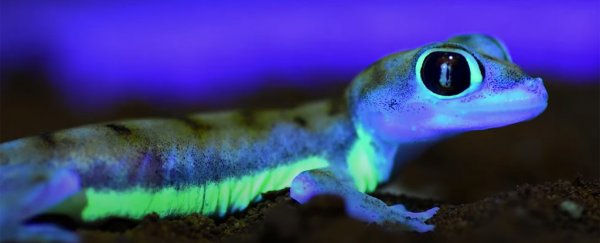A desert gecko from Namibia has brilliant glow-in-the-dark markings that shine neon green by the light of the moon. The mechanism that produces its glow has never been seen before in land animals with backbones.
Web-footed geckos (Pachydactylus rangei) have translucent skin with large, yellowish markings: stripes on their sides and rings surrounding their eyes. But those markings light up brightly when they absorb the moon's bluer light.
Fluorescence — when light is absorbed and then emitted at a longer wavelength — has been found in other reptiles and amphibians, produced by their bones or by chemical secretions in their skin. However, web-footed geckos generate their light using skin pigment cells that are filled with guanine crystals.
These cells, called iridophores, have previously been linked to color display in geckos and lizards, but this is the first evidence that they also enable geckos to glow in the dark.
Web-footed geckos, which live in dry riverbeds and dunes in the Namib desert, measure about 4 to 6 inches (10 to 15 centimeters) in length, according to Animal Diversity Web (ADW), a wildlife database maintained by the University of Michigan's Museum of Zoology.
The geckos use their large, webbed feet to burrow through fine sand, and they are mostly active at night, ADW says.
In 2018, the study authors had found that chameleons have bones that glow through their skin. That discovery prompted the scientists to look for hidden glows in other reptiles and amphibians, said study co-author Mark Scherz, a postdoctoral researcher with the Adaptive Genomics Group at Universität Potsdam in Germany.
David Prötzel, lead author on this study and a doctoral candidate at the Bavarian State Collection of Zoology (ZSM) in Munich, kept P. rangei geckos at home, and got "an incredible surprise" when he shone a UV light on his web-footed geckos and discovered that they glowed neon green, Scherz told Live Science in an email.
The researchers then tested 55 P. rangei specimens from ZSM under UV light, finding evidence of fluorescence in adults of both sexes and in juveniles.
In other fluorescent amphibians, such as the polka-dot tree frog (Boana punctata), the glow comes from a chemical that circulates through its lymph system.

And reptiles such as chameleons and saddleback toads in the Brachycephalus genus display fluorescent bones through body regions where their skin is very thin.
"Actually it turns out quite a few other species, including geckos, have sufficiently transparent skin that their bones' fluorescence can be seen through it under a sufficiently strong UV light," Scherz said.
But in the web-footed geckos, the bright neon-green glow came from iridophores. Though iridophores were not previously associated with fluorescence in geckos, they are known to fluoresce in some species of reef fish, according to the study.
The web-footed gecko is the first known gecko to possess two types of iridophores: one that fluoresces, and one that doesn't.
The glow that these cells produce is brighter than the glow emanating from chameleons' bones and is among the brightest examples of fluorescence in land animals, the study authors reported.
Such luminous markings along the lower body and around the eye would be highly visible to other geckos, "but would be hidden from predators with higher vantage points, such as owls or jackals," Scherz said.
While scientists don't know how most animals use their fluorescence, the location and brightness of these markings, as well as their visibility in the geckos' arid desert environment, where there isn't much vegetation, suggests that fluorescence plays a role in the geckos' social interaction, according to the study.
"We have observed in captivity that, although these animals are largely solitary, they do run up to one another to greet each other after a short period of separation," Scherz said. "They also lick condensation from each other's bodies. So there are lots of reasons that being able to see each other over long distances would be useful for these geckos," he said.
The findings were published online Jan. 11 in the journal Scientific Reports.
This article was originally published by Live Science. Read the original article here.
